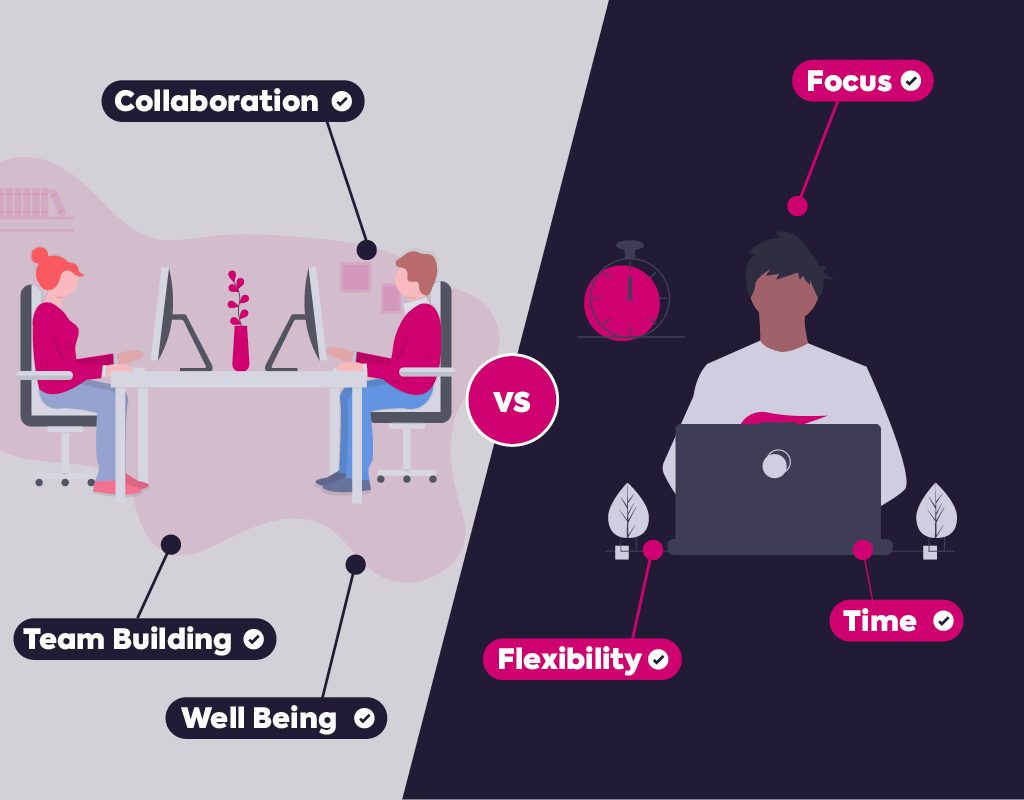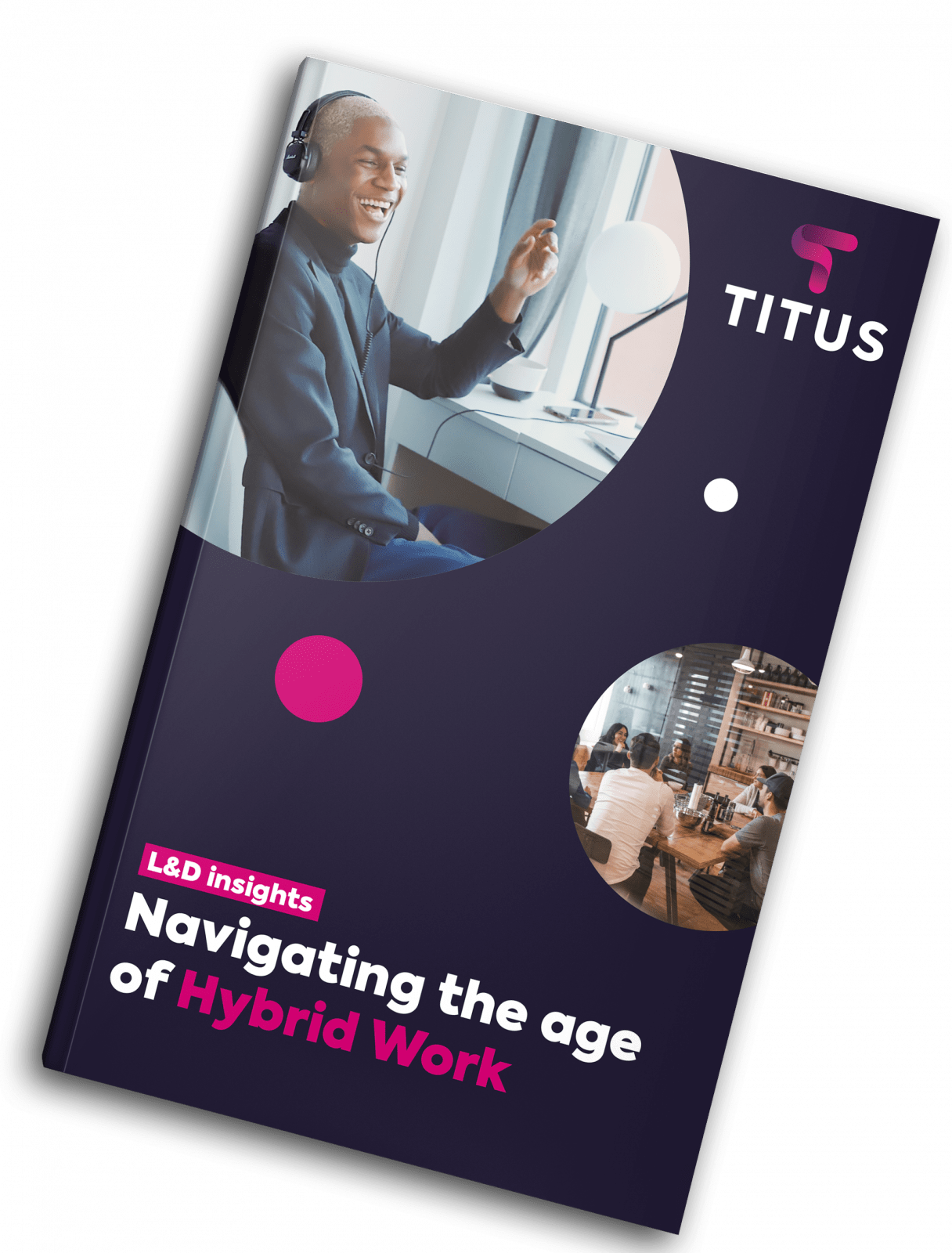- Home
- Our Solutions
Titus Services
Unlock Moodle's Potential with Titus
Migrate to Titus and transform how you use Moodle in your organisation. - Industries
- Our Work
- About
- Blog


Home - Blog - e-Learning Advice - Hybrid Working is here to stay – how to find the right balance between home & office
Hybrid working is all about balance. The rapid shift to remote working which many of us experienced in 2020 was an opportunity to re-evaluate what we missed (and definitely didn’t miss) about daily office work. It also brought into focus the challenges that come with working from home full-time, as well as the benefits.
For organisations setting out, or continuing on the path of hybrid working, these lessons are valuable in helping to strike the right balance, optimising how we divide our time, activities and resources between in-person and remote work. In this article, we look at four areas where balance is essential, and how the hybrid model can help businesses get the best of both worlds.
01 Home vs Office

The balance between remote and office-based work is at the centre of the hybrid working model. Much of the advice and guidance we’ve seen on this topic focuses on how organisations can figure out the right formula for flexible working. Our view is that as far as possible, employees should be able to influence their own schedule according to what helps them be most productive.
It’s important to remember though, that for many employees, an entirely flexible schedule isn’t realistic – their job may require them to be on-site much of the time, or conversely, their location might mean that the majority of their work is done remotely.
Employers, therefore, need to be more creative to ensure these employees are treated equally – whether that’s providing cover to allow on-site workers a break from the office every couple of weeks, or access to co-working space for remote team members who need to get out of the house once in a while.
The new world of flexible and remote working sounds like a dream, but isn’t without its challenges. Grab your copy of our free guide to deciphering what hybrid working really means for your organisation.

02 Collaboration vs Productivity
Remote workers often cite increased focus as a major benefit of working away from the office, with the lack of distractions caused by phone calls, background noise or ad-hoc meetings improving their ability to concentrate, particularly on complex or involved tasks.
On the other hand, many office workers value the immediate connections and interactions which come with having everyone under the same roof, allowing for quicker decision making and deeper collaboration.
A hybrid model offers the opportunity to improve each environment – with more conscious planning of in-person time leading to less disruption for office workers while making the sessions themselves more valuable. Similarly, a communications policy that encourages informal catch-ups with remote workers, but advises against unscheduled interruptions helps to maintain the right balance between productivity and inclusion.
03 Management vs Leadership
With a reduction in face-to-face time, those in management and leadership roles face a new set of challenges in how they connect with employees. Many of the technological solutions available focus on quantitative, rather than qualitative metrics, and it can be easy to slip into the “management by numbers” habit, focusing on tasks and productivity alone.
While these are important, it’s vital for leaders to keep inspiring and motivating from the top, in order to sustain the company culture, keep the workforce informed about strategy and direction, and ensure that all employees feel recognised, supported and appreciated.
Organisations need to ensure that leadership is prioritised within the hybrid model, creating space and time for regular catch-ups and briefings, whether in-person or virtually. Visibility is key, to avoid a scenario in which in-office staff have a disproportionately higher perception of support than their colleagues working remotely.
04 Formal vs Informal
While tools such as Zoom or Teams do a good job of replacing the functional aspect of face-to-face meetings, they don’t allow for much non-verbal communication. Tone can be difficult to judge online, and as a result video conferences tend towards a higher level of formality.
Equally, in-person meetings can be too informal. We’ve all been guilty of calling a meeting at short notice without a defined agenda and sometimes without much thought as to how many of the invitees really need to be involved.
Adopting a hybrid working model challenges us to confront these issues. Online meetings can be improved by adding some time at the beginning or end for social interaction and giving participants access to virtual breakout rooms post-discussion to collaborate on the issues discussed. Face-to-face meetings are less common in a hybrid workplace, so to make the most of the opportunity, we need to think carefully about their purpose and structure.
The new world of flexible and remote working sounds like a dream, but isn’t without its challenges. Grab your copy of our free guide to deciphering what hybrid working really means for your organisation.

In our next article on hybrid working, we’ll be looking at how choosing the right technologies – and more importantly, knowing how best to deploy them – is crucial to the foundation of a successful and productive hybrid workplace.
In the meantime, if you’re looking for advice on how online learning can help manage and support employees as you move towards a hybrid learning model, get in touch with one of our team.

Privacy Policy | Cookie Policy | Data Protection Policy | Equality, Diversity and Inclusion Policy
© 2023 Titus Learning LTD | Company Number 08799881 | VAT Number 1813 09027
Super talented, unflappable and very funny, Phuong supports the whole marketing team in her role as Digital Marketing Executive. Phuong holds a bachelor’s degree in Business Administration and recently completed a master’s degree in Management and Marketing. Originally from Hanoi in Vietnam, Phuong is now based in the UK and climatising brilliantly to our weather and food.
Phuong owns a food review Instagram page as travelling and food are her passion. She also has a cute little french bulldog.
Ellie was the first woman to join Titus and has paved the way for many more since then. After studying for a degree in Fashion and Marketing, Ellie was lucky to find herself at fashion weeks and photoshoots.
Now she’s switched from talk of the front row to front end design and has brought loads of transferable knowledge to Titus. Ellie has also found a real passion for tech, especially in the learning sector, helping clients create positive change for their organisations.
As one of the youngest people at Titus but at the same time one of the oldest serving members of the team, Callum has graced Titus with his broad smile and positive attitude for over 5 years now. As a key member of the marketing team, Callum works across all areas, both on and offline, to ensure that all Titus brands and communication are on point.
After missing out on the opportunity to go to University the first time around, management encouraged him to enrol in our course alongside his work. He is now studying to achieve his Level 6 Diploma in Professional Digital Marketing.
Always bringing innovation and new ideas, Dec studied a degree in Journalism but found his passion in digital marketing. Dec has also worked in marketing for one of the countries biggest retailers and within the property sector.
Outside work, Dec Co-founded a news publication where he collaborated with global brands like Uber, Amazon, BooHoo and countless SMEs.